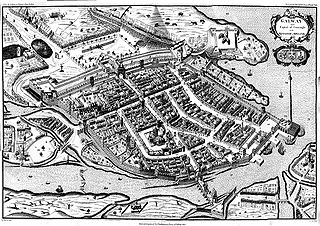Related Research Articles

The Tribes of Galway were 14 merchant families who dominated the political, commercial and social life of the city of Galway in western Ireland between the mid-13th and late 19th centuries. They were the families of Athy, Blake, Bodkin, Browne, D'Arcy, Deane, Font, Ffrench, Joyce, Kirwan, Lynch, Martin, Morris and Skerritt. Of the 14 families, 12 were of Anglo Norman origin, while two — the D'Arcy and Kirwan families — were Normanised Irish Gaels.

The Irish Confederate Wars, also called the Eleven Years' War, took place in Ireland between 1641 and 1653. It was the Irish theatre of the Wars of the Three Kingdoms – a series of civil wars in the kingdoms of Ireland, England and Scotland. The war in Ireland began with a rebellion in 1641 by Irish Catholics, who tried to seize control of the English administration in Ireland to force concessions for Catholics. This developed into an ethnic conflict between Gaelic Irish and old English Catholics on one side, and English and Scottish Protestant colonists on the other. Catholic leaders formed the Irish Catholic Confederation in 1642, which controlled most of Ireland and was loosely aligned with the Royalists. The Confederates and Royalists fought against the English Parliamentarians and Scottish Covenanters. In 1649, a Parliamentarian army led by Oliver Cromwell invaded Ireland and by 1653 had conquered the island.
Richard Óge Martyn was a Galway lawyer and member of the Catholic Confederates of Ireland. He was of the senior line of the Martyn family, one of the Tribes of Galway. He lived at Dunguaire Castle, Kinvarra. He worked with his brother-in-law and first cousin, Patrick Darcy, against the Plantation of Connaught in the 1630s, and served on the Supreme Council of the Confederate Catholics in the 1640s. Martyn also served as Mayor of Galway, 1642–1643. He and Darcy were part of a network of Catholic lawyers in Galway who contrived to continue in practice in defiance of the Penal Laws, which barred Catholics from the professions. Richard was admitted to the King's Inns in 1631: he was suspended from practice at the Irish Bar in 1635 as a known Catholic, but permitted to resume practice in 1637, apparently because he had sworn the Oath of Supremacy.

Confederate Ireland or the Union of the Irish was the period of Irish self-government between 1642 and 1649, during the Eleven Years' War. During this time, two-thirds of Ireland was governed by the Irish Catholic Confederation, also known as the Confederation of Kilkenny because it was based in Kilkenny. It was formed by Irish Catholic nobles, clergy and military leaders after the Irish Rebellion of 1641. The Confederation had what were effectively a parliament, an executive, and a military. It pledged allegiance to Charles I.

Donough MacCarthy, 1st Earl of Clancarty, 2nd Viscount Muskerry (1594–1665), was a leader of the Irish Confederation. He led the Confederates' Munster army during most of the Irish Confederate Wars and the Cromwellian conquest of Ireland. He belonged to the moderate faction, which wanted to collaborate with the royalists against the Commonwealth and the Covenanters. He was one of the last to surrender. In 1658, in exile, Charles II created him Earl of Clancarty. He recovered his lands at the Restoration.

The Siege of Galway took place from August 1651 to May 1652 during the Cromwellian conquest of Ireland. Galway was the last city held by Irish Catholic forces in Ireland and its fall signalled the end to most organised resistance to the Parliamentarian conquest of the country.
Patrick Darcy (1598–1668) was an Irish Catholic Confederate and lawyer who wrote the constitution of Confederate Ireland.
Sir Nicholas Plunkett (1602–1680) was an Anglo-Irish lawyer and politician. The son of Christopher Plunkett, 9th Baron Killeen and Jane Dillon, daughter of Sir Lucas Dillon, his brother Luke was created Earl of Fingall in 1628. At the age of twenty Plunkett traveled to London to receive training as a lawyer at Gray's Inn in London, and later trained at King's Inn in Dublin. By the 1630s he had established a thriving legal practice: the attempts by Thomas Wentworth, the Lord Lieutenant of Ireland, to confiscate as much Irish land as possible to the Crown, ensured that his services were in high demand. At this time he also became an MP in the Irish House of Commons, sitting for Meath.
Dominick Lynch was mayor of Galway, Ireland.
Walter Lynch (Mayor), Mayor of Galway, fl. 1641-1642.
Dominick Kirwin was an Irish Confederate, fl. 1642–1653?
John Blake fitz William, third Mayor of Galway, 1487–1488.
Richard Burke, 6th Earl of Clanricarde, Irish peer, died August 1666.
Sir Henry Lynch, 1st Baronet was an Irish knight and land agent.
James Riabhach Darcy was Mayor of Galway in Ireland 1602–1603.
Dominic Burke was an Irish Dominican priest and political agent.
Oliver Burke was a Dominican priest and ecclesiastical administrator, and Bishop of Kilmacduagh.
Maire Lynch, Countess of Clanricarde, fl. 1547.
John Lambert of Creg Clare was an Irish soldier and Royalist.
Gerald Fennell was an Irish doctor and politician of the seventeenth century. He is notable for his leadership role in Confederate Ireland where he sat on the Supreme Council in Kilkenny. He is identified with the Moderate Faction of the Conderates, and strongly supported a peace agreement with the Irish government.
References
- Pedigree of the Brownes of Castle mac Garrett, Lord Oranmore and Browne, Journal of the Galway Archaeological and Historical Society, volume 5, 1907–08.
- Old Galway, Maureen Donovan O'Sullivan, Oxford, 1942
- Confederate Ireland 1642–49, Micheal O'Siochru, Four Courts Press, Dublin, 1999
- Kingdoms in Crisis: Ireland in the 1640s, Micheál Ó Siochrú, ed., Dublin, 2000.
- The Tribes of Galway, Adrian James Martyn, Galway, 2001
- Dictionary of Irish Biography:from the Earliest Times to the Year 2002, p. 903, Cambridge, 2010